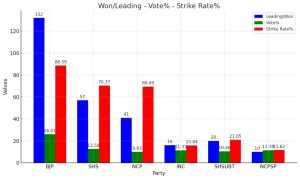With the current assembly election outcome in Maharashtra, the BJP has cemented its position as the main political pole of the state. Going by the trends and results available so far, based on the Election Commission of India dataset, the party has won 125 assembly seats and is leading on 7. That means a 132-seat count or 46% seat share in a 288-member state assembly.

The BJP-led alliance Mahayuti is expected to win 234 seats, crossing comfortably the majority mark of 145 and thus retaining the government. Alliance partner and Maharashtra’s Chief Minister Eknath Shinde-led Shiv Sena has won 55 seats and is leading on two more, while Maharashtra Deputy CM Ajit Pawar-led NCP has got 41 seats. Other smaller parties in the alliance have won four seats. The combined vote share of the three main parties comes out to be 48.16%. With other smaller parties of the alliance, the Mahayuti is expected to cross the 50% vote share mark.
THE MAHARASHTRA JOURNEY
The BJP emerged as the single largest party in the state in the 2014 assembly election, maintained it in 2019, and looks to better its performance this time. In 2014, the party won 122 assembly seats with a strike rate of 47%. With the counting trends available so far, the party looks to settle down with 132 seats, ten more than its 2014 tally, and a stupendous strike rate of 88.59%. This means the BJP is winning almost nine of every ten contested seats.

The party started its journey in Maharashtra in 1980, the year of its formation as a political party in India. That year, it won 14 seats with a 9.38% vote share. Since then, the party has seen consistent electoral progress in the state. It won 16 seats in the 1985 assembly election, which increased to 42 in 1990, with the BJP forming an alliance with the Bal Thackeray-led Shiv Sena in 1989.
The party won 65 seats in the 1995 assembly election when the BJP-Shiv Sena combine formed the government in the state. The party’s seat tally remained in the range of 50 seats per election until 2009, with the Congress-NCP coalition government ruling the state from 1999 to 2014.

The BJP’s increasing footprint can be seen in its growing vote share in the state. It shows a steady increase election after election, from sub-10% levels to over 25% vote share now.
2014: THE NARENDRA MODI FACTOR AND THE CENTURY MARK
The electoral dominance created by the “Modi Wave,” with India’s current Prime Minister Narendra Modi leading the campaign that year, led to unprecedented success for the BJP in the 2014 Lok Sabha election. For the first time since 1984, a single party achieved a majority in the Lok Sabha election. The Maharashtra assembly election later the same year became another success story.
No political party had touched the 100-seat mark in Maharashtra since the 1990 state assembly election. The BJP, riding the Narendra Modi wave, shattered that trend, winning 122 seats and emerging as the largest party in the state.
Since then, the party has won over 100 seats in each assembly election: it won 105 seats in 2019 and is winning or leading in 132 seats in the 2024 election so far. The party’s continued success in Maharashtra is yet another testimony to the PM Narendra Modi factor in electoral politics in the country.
TWICE AS LARGE AS OTHER PARTIES IN THE STATE
The electoral performance of the BJP has made it almost twice as large as other parties in the state, be it its allies like the Shiv Sena or the NCP, or rivals like the Congress, the Shiv Sena (UBT), or the NCP (SP), a trend continuing since the 2014 assembly election.

Its vote share was 8 to 10% higher than other political parties in the last two assembly polls. This year, it is over 13% higher than its ally, the Shiv Sena, so far. In the 2019 Maharashtra assembly election, the average vote share of the other three large parties in the state, other than the BJP (the Congress, the Shiv Sena, and the NCP), was 16.33% against the BJP’s 25.75%.
In 2014, it was 18.18% against the BJP’s 28.81%. The current assembly election has seen their average vote share drop to 15%. Other than the BJP, the state has four other main political parties contesting this time: Shiv Sena and Shiv Sena (UBT), and NCP and NCP (SP). Their average vote share is 11% against the BJP’s 26%.
When it comes to the number of seats, the BJP has performed spectacularly. Going by the trends available so far for the current election, the party has gained 75 more seats than the second-largest party in the state, or 18 seats more than double the number of seats of Shiv Sena, its alliance partner. In the 2019 and 2014 assembly elections, the BJP’s seat count was almost double what other parties got.
from National https://ift.tt/aW8bMrk
